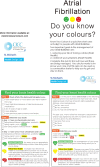Use of an interdisciplinary, participatory design approach to develop a usable patient self-assessment tool in atrial fibrillation
- PMID: 24235817
- PMCID: PMC3821835
- DOI: 10.2147/PPA.S51285
Use of an interdisciplinary, participatory design approach to develop a usable patient self-assessment tool in atrial fibrillation
Abstract
After identifying that significant care gaps exist within the management of atrial fibrillation (AF), a patient-focused tool was developed to help patients better assess and manage their AF. This tool aims to provide education and awareness regarding the management of symptoms and stroke risk associated with AF, while engaging patients to identify if their condition is optimally managed and to become involved in their own care. An interdisciplinary group of health care providers and designers worked together in a participatory design approach to develop the tool with input from patients. Usability testing was completed with 22 patients of varying demographics to represent the characteristics of the patient population. The findings from usability testing interviews were used to further improve and develop the tool to improve ease of use. A physician-facing tool was also developed to help to explain the tool and provide a brief summary of the 2012 Canadian Cardiovascular Society atrial fibrillation guidelines. By incorporating patient input and human-centered design with the knowledge, experience, and medical expertise of health care providers, we have used an approach in developing the tool that tries to more effectively meet patients' needs.
Keywords: atrial fibrillation; care gaps; patient care tools; patient education; patient self-assessment.
Figures
References
-
- Wolf PA, Abbot RD, Kannel WB. Atrial fibrillation: a major contributor to stroke in the elderly. The Framingham Study. Arch Intern Med. 1987;147(9):1561–1564. - PubMed
-
- Gooden JY, Powell BD, Akogyeram CO, Melduni RM. Recent advances in the pharmacological management of atrial fibrillation. Am J Ther. 2013 May 17; Epub. - PubMed
-
- Atzema CL, Austin PC, Miller E, Chong AS, Yun L, Dorian P. A population-based description of atrial fibrillation in the emergency department, 2002 to 2010. Ann Emerg Med. June2013 Epub. - PubMed
-
- Wattigney WA, Mensah GA, Croft JB. Increasing trends in hospitalization for atrial fibrillation in the United States, 1985 through 1999: implications for primary prevention. Circulation. 2003;108(6):711–716. - PubMed
-
- Gladstone DJ, Bui E, Fang J, et al. Potentially preventable strokes in high-risk patients with atrial fibrillation who are not adequately anticoagulated. Stroke. 2009;40(1):235–240. - PubMed
Publication types
LinkOut - more resources
Full Text Sources
Other Literature Sources





